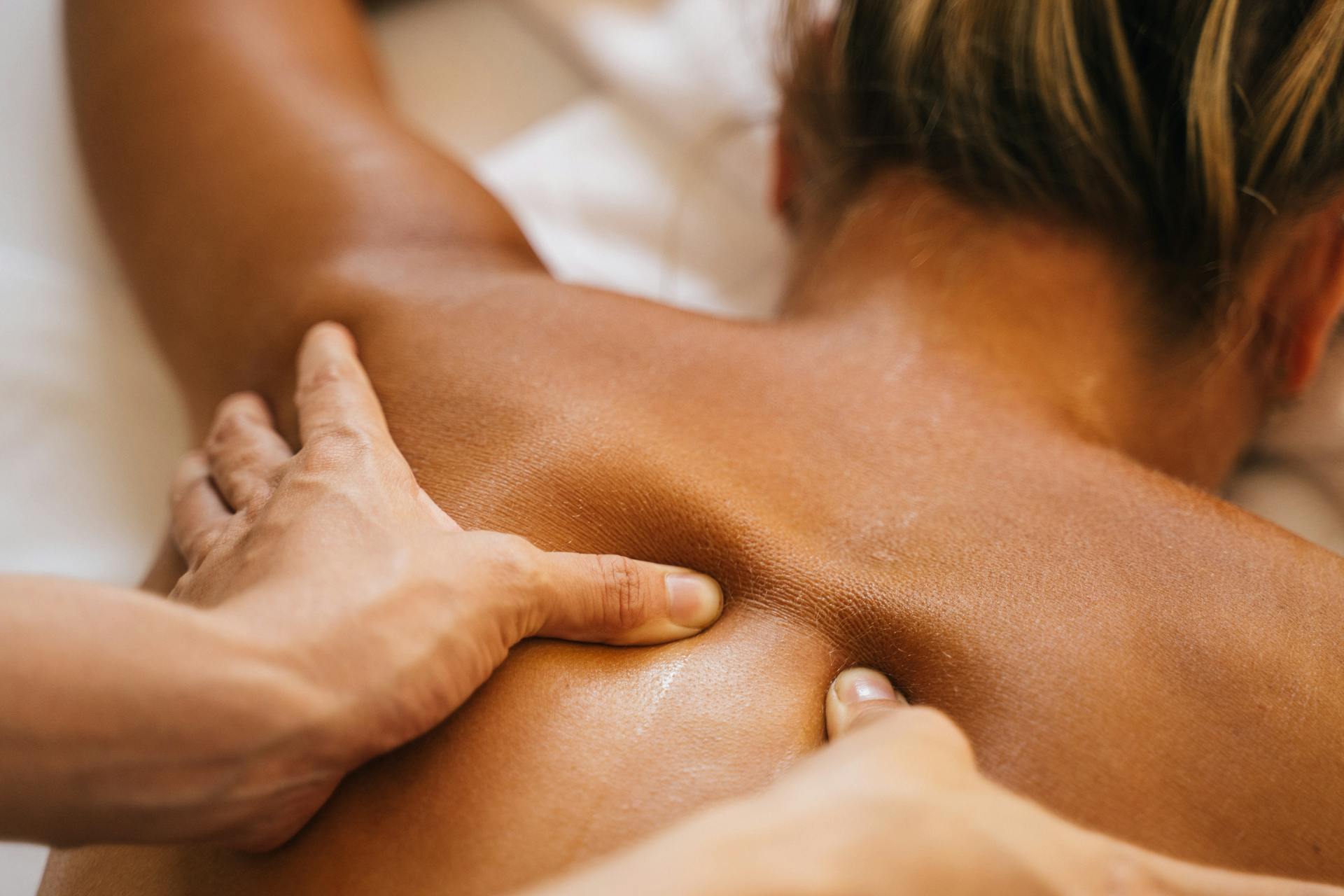Key Takeaways
- Toxins are unwanted substances that build up in the body for various external and internal reasons.
- Massage therapy can help flush out toxins like lactic acid, cortisol, histamine, and metabolic waste.
- Removing toxins can ease pain, reduce inflammation, improve mood, and boost overall well-being.
Toxins are a natural poison—substances that harm your body by interfering with normal function. Some sneak in through the air we breathe or the food we eat. Even our skin can absorb toxins like mercury or harsh chemicals. Some others are produced internally.
Thankfully, our bodies can handle a lot. Regular exercise, healthy eating, staying active, and limiting alcohol all support the body’s natural detox process. But if you’re looking to give your system an extra nudge, massages may offer another way to support detoxification.
But what toxins are released after massage? Think acids, hormones, and waste—products your body sometimes struggles to clear out on its own.
What Toxins Are Released After Massage?
Many people think massages are just about easing muscle tension and unwinding. But have you ever stopped to wonder why that relief happens? What’s actually going on inside your body when those knots begin to loosen, and the stress seems to melt away?
Surprisingly, many of the benefits linked to massage therapy, like reduced soreness, improved circulation, and mental clarity, are connected to the toxins released after massage.
Some specific toxins massage can help flush out of your system include:
Lactic acid

If you’ve ever felt a burning sensation during an intense workout, you’ve already dealt with the negative effects of lactic acid. This acid is a byproduct of intense muscle use—essentially, your body creates it when it needs energy fast and doesn’t have enough oxygen to produce it more efficiently. After a tough gym session or long run, lactic acid can build up and cause soreness or fatigue.
Massage can help your body deal with this internal toxin by stimulating blood flow and softening the muscle tissue. The improved circulation helps your lymphatic system carry waste away more effectively, thus speeding up recovery and even easing post-exercise stiffness.
After a massage targeting this toxin, it’s important to drink plenty of water to support your kidneys and help flush the waste from your body. Light stretching and rest can also keep you feeling limber and energized.
Cytokines
You may have heard the word “inflammation” tossed around in health conversations—that’s how cytokines do their damage. These are small proteins your immune system releases to help regulate inflammation and cell communication. They’re needed when your body is healing, but too many of them can create what is known as systemic inflammation or excessive inflammation, especially in muscles that are overworked or stressed.
Medical massage helps balance this by stimulating the parasympathetic nervous system. In turn, the system may reduce the production of pro-inflammatory cytokines. At the same time, it may even increase levels of anti-inflammatory cytokines. That means less chronic soreness and a lower chance of inflammation-related pain.
Following a massage aimed at reducing inflammation, it’s advised to support the benefits by avoiding processed foods and alcohol, which can re-trigger inflammatory responses. A warm bath with Epsom salts or gentle movement like walking are the best options for aftercare as they can help extend the calming effects.
Cortisol

Cortisol is more widely known as the “stress hormone,” and for good reason. If you’ve ever felt your heart race or your body tense up in a high-pressure situation, cortisol was technically the reason behind it. This hormone is produced by your adrenal glands in response to stress.
Cortisol is beneficial in the sense that it helps your body react quickly when you’re in danger. However, too much cortisol over time can lead to anxiety, poor sleep, weight gain, and even weakened immunity.
Massage therapy has been shown to lower cortisol levels by triggering your parasympathetic nervous system, which helps your body shift out of that constant fight-or-flight mode. Once the cortisol levels drop, you’ll feel calmer and have more stable energy levels throughout the day.
To help your body hold onto that calm post-massage state, you should avoid jumping back into stressful activities right away. Give yourself time to rest, journal, or take a slow walk, and make sure to stay hydrated and eat nourishing meals.
Histamine
Most people associate histamine with allergies—sneezing, watery eyes, skin rashes, and many other annoying symptoms. However, histamine has a broader role in regulating immune response and blood flow. It gets released by your cells during inflammation, injury, or allergic reactions to help defend the body. Still, similar to cortisol, too much of it or poor circulation will cause you to suffer from itchiness, swelling, or congestion.
Massage can help regulate this toxin by encouraging better blood and lymph flow, which assists in moving excess histamine out of tissues. In some cases, you might feel a bit itchy or flushed during or even after the massage, but this is normal and often a sign that histamine is being stirred up and released.
If you’re sensitive to histamine, let your massage therapist know in advance. For aftercare, make sure to drink water, use a cool compress afterward, and avoid histamine-triggering foods, such as aged cheese or red wine, for the rest of the day.
Metabolic waste products

Metabolic waste are byproducts your body naturally produces as it creates energy—like carbon dioxide, urea, and creatinine. Under normal conditions, your lymphatic system flushes them out. But when circulation slows, or muscles are overworked, this waste can linger and even cause stiffness or fatigue.
Massage therapy can help stimulate blood and lymph flow, thus helping your body flush these waste products more efficiently. By releasing tight muscles and encouraging drainage, massage allows your body to move metabolic waste out of tissues and back into circulation to be processed and eliminated.
For aftercare, make sure to, once again, drink plenty of water in order to help your kidneys and liver do their job. A warm bath with Epsom salts also doesn’t hurt, as it can aid detox and soothe any lingering soreness.
Adrenaline and noradrenaline
Adrenaline is essentially that sudden jolt you feel when something startles you. This, as well as its partner noradrenaline, are stress hormones most commonly released during moments of excitement, danger, or anxiety.
These two hormones prime your body for action by increasing heart rate, sharpening focus, and slightly tightening muscles. But when these hormones linger due to chronic stress, they can wear you down physically and mentally.
Massage therapy can help you counteract this overactivation by activating the body’s relaxation response. As muscles loosen and breathing deepens, the nervous system signals that it’s safe to release the grip of adrenaline and noradrenaline.
To avoid these two hormones, you should stay clear of overstimulating environments and instead engage in activities that ease your body into full rest mode.
Common Side Effects of Massage

Like most things that affect your body, massage therapy has potential downsides. While it offers many benefits, it’s important to stay aware of the side effects that may come along, so you can go in prepared and get the most out of the experience.
Some of the most common side effects include:
- Muscle soreness
- Mild queasiness
- Headaches
- Fatigue
- Minor bruising
- Skin irritation
- Emotional reactions
Most of these side effects are mild and fade quickly, especially when you’re in the care of a skilled massage therapist. Many can even be avoided with proper hydration, communication, and awareness of your body’s needs.
However, if pain, dizziness, rashes, or emotional distress feel severe or last longer than expected, it’s best to reach out to a healthcare professional in order to make sure that everything’s okay.
Key Benefits of Toxin Release Through Massage
The release and, in certain cases, the subsequent elimination of toxins can lead to several positive physiological and psychological outcomes. Among them, the key benefits include:
Enhanced circulation
Research suggests that massage significantly improves blood flow in both the skin and muscles after localized fatigue. An experimental study demonstrated that compared to rest, participants who received massage showed a greater increase in muscle blood volume (MBV) and skin blood flow (SBF), indicating enhanced circulation in the treated area.
Improved lymphatic drainage
According to a systematic review of the efficacy of manual lymphatic drainage techniques (MLDTs) massages can enhance lymphatic flow and reduce swelling, particularly in the context of sports injuries and rehabilitation.
The evidence from randomized controlled trials indicates that MLDTs may effectively reduce edema and help clear metabolic byproducts like muscle enzymes following intense physical activity. These effects are likely due to the stimulation of lymphatic circulation, which aids in moving fluid, waste, and immune factors more efficiently through the body.
Reduced stress

Massage therapy is also widely recognized for its ability to ease emotional stress. While massage professionals often observe this firsthand, scientific studies have also confirmed its effectiveness.
Research involving trigger point therapy found that participants experienced notable drops in heart rate and blood pressure. Other controlled studies showed that just 10 to 15 minutes of chair massage could reduce oxygen consumption, lower cortisol levels in saliva, and decrease both systolic and diastolic blood pressure.
Enhanced immune function
Massage therapy may also positively influence immune function, particularly with weekly sessions. A study on this matter showed that participants who received Swedish massage once a week over five weeks showed increased levels of circulating lymphocyte markers—key cells that help the immune system respond to threats. This boost in immune cell activity indicates that massage may help strengthen the body’s natural defense mechanisms.
Additionally, weekly massage sessions were linked to a reduction in pro-inflammatory cytokines, which suggests a balancing effect on immune responses.
Improved mental clarity and mood
Massage therapy can also have a positive effect on mental health as it helps boost both mental clarity and mood. It does so by triggering hormonal and physical responses that help the body and mind reset.
As the massage works through built-up muscle tension, it encourages the release of endorphins, known as natural mood enhancers, while also lowering cortisol levels, which are closely linked to stress. This shift in hormone balance supports a calmer, more focused mental state and a more stable, uplifted mood.
Best Massages for Releasing Toxins

There are many different types of massage therapy, and while most offer benefits for circulation, relaxation, and tension relief, some are especially effective when it comes to stimulating the lymphatic system and promoting toxin release. These include:
- Lymphatic drainage massage
- Deep tissue massage
- Swedish massage
- Thai massage
- Myofascial release
- Hot stone massage
- Sports massage
- Reflexology
Conclusion
If you’re constantly feeling run-down, tense, or just a bit mentally foggy, it might be time to get a massage and help your body detox. Although your immune system should naturally eliminate some toxins, a little support can go a long way. We’ve clearly seen how massage therapy can help flush out these substances and boost overall wellness.
Even if you’re not in need of this help, you might be interested in bringing that relief to others. In that case, consider training in medical massage therapy at AIAM, as our program prepares you with the skills and knowledge to help people detox and feel better in their bodies and minds.
Frequently Asked Questions (FAQs):
What are the symptoms of detoxing after a massage?
Some symptoms can include fatigue, headaches, and soreness. But usually, they are mild and manageable.
What body systems are most affected by massage?
Massage primarily supports the circulatory, lymphatic, muscular, and nervous systems.
What happens to your body after a full body massage?
After such a massage, your muscles relax, circulation improves, stress hormones drop, and the body begins clearing out built-up waste and tension.